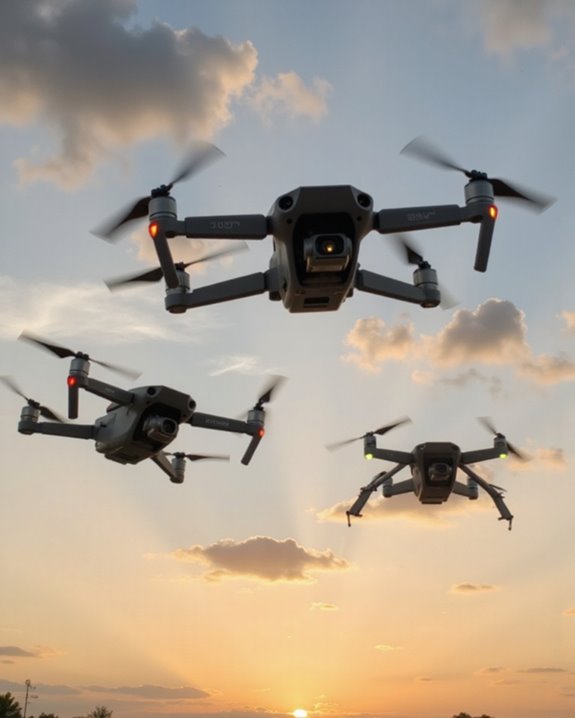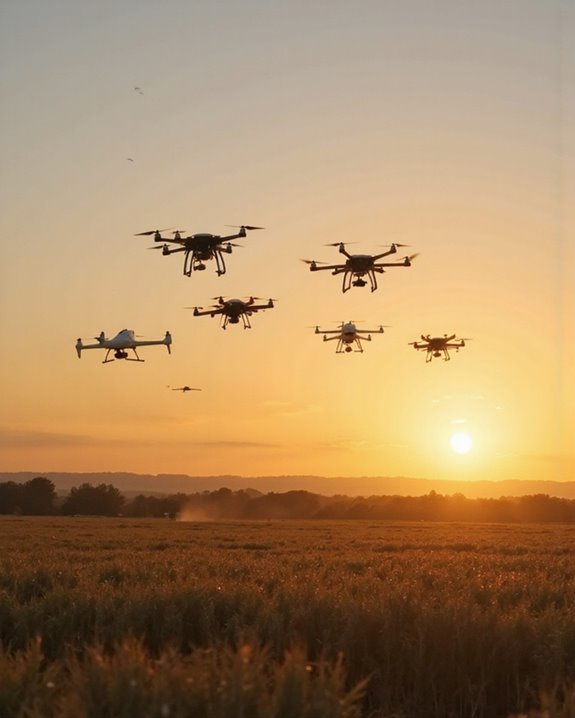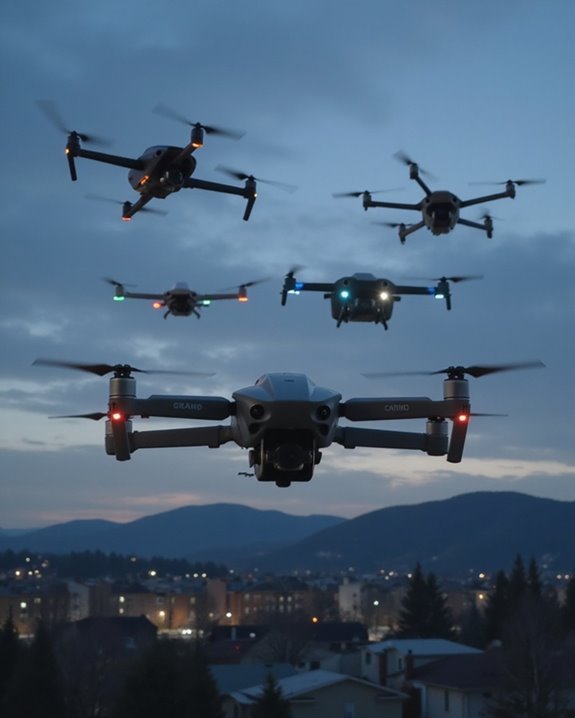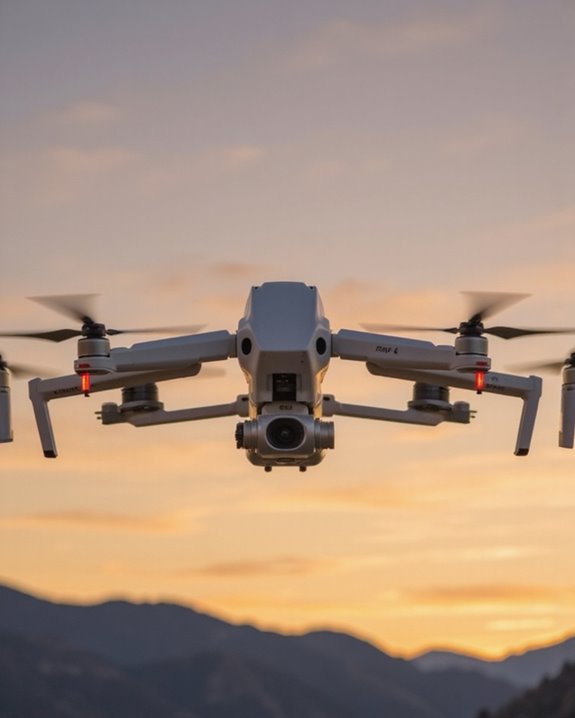For professional-grade aerial photography in 2025, you’ll want to check out these top performers! The V168 leads the pack with stunning 8K footage, 50x magnification, and an impressive 60-minute flight time across three batteries. The Velcase S101 offers 1080p quality with voice control and 26-minute flights, while the SIMREX X800 delivers reliable 1080p shots with a 90-degree adjustable lens. Let’s explore what makes each of these aerial photographers’ dream machines tick.
Key Takeaways
- V168 leads professional aerial photography with 8K footage, 50x magnification, and gyroscope stability for the highest quality shots.
- Extended flight capabilities of 60 minutes from three batteries allow V168 users to capture comprehensive aerial footage without interruption.
- Professional-grade drones in the $200+ range offer advanced features like GPS navigation, waypoint mapping, and 4-way obstacle avoidance.
- The V168’s 1,640-foot transmission range with 5G technology ensures reliable FPV streaming for real-time professional monitoring.
- Advanced optical sensors, level 6 wind resistance, and stabilization technology maintain steady footage during challenging environmental conditions.
Foldable HD Camera Drone for Beginners with Voice Control
- 1080P HD Camera Adjustable FPV Drone & APP Control-- Equipped with an adjustable-angle 1080P HD camera, this drone is capable of capturing stunning aerial photos and...
- Multiple Functions for Kids Beginners--Features: optical flow positioning, barometric altitude hold, 3D flips, headless mode, three-speed modes, one-key...
- Foldable Drone, Full Accessories, Thoughtful design-- The package includes a portable bag for convenient outdoor travel. Equipped with two 1050mAh batteries, enjoy an...
Looking for the perfect entry-level drone that won’t overwhelm you with complexity? The Velcase S101 packs impressive features into a beginner-friendly package, including voice control and optical flow positioning that’ll keep you from crashing into trees!
You’ll love the 1080p HD camera that captures crisp aerial photos and videos, while gesture controls let you snap shots with a wave of your hand. With three speed modes and one-key takeoff/landing, you’re never more than a button press away from smooth flying. The foldable design and included carrying case make it perfect for adventures, while two batteries give you a generous 26 minutes of flight time to perfect those 360° flips.
Best For: Beginner drone pilots looking for an affordable entry-level camera drone with user-friendly features and voice control capabilities.
Pros:
- Extended 26-minute flight time with two included batteries and easy-to-use controls perfect for learning
- Impressive feature set including 1080p HD camera, gesture controls, and optical flow positioning
- Portable design with foldable body and carrying case included for easy transport
Cons:
- Poor performance in windy conditions limits outdoor flying opportunities
- Build quality concerns with some reports of fragility and defects
- Camera quality, while HD, may not meet expectations of more serious photographers
RC Quadcopter Drone with 1080P Camera and Remote Control
- [Foldable and Portable Design]: SIMREX X800 mini drone is light, equipped with a 1080P camera, adjustable 90 lens, and weighs only 96g. It is fashionable and lightweight,...
- [Altitude Hold & Optical Flow Positioning] The altitude hold function can keep the drone hovering at a fixed height to help you get wonderful videos and photos. In...
- [One Key Start/Landing] Our remote-controlled drone has a one-key start/landing button, which can be easily and conveniently controlled, allowing you to enjoy one-button...
For beginners and casual pilots who don’t want to break the bank, the SIMREX X800 delivers impressive capabilities in an ultra-portable package. At just 96 grams, this foldable drone won’t weigh you down but still packs a punch with its 1080P camera, 90-degree adjustable lens, and impressive 22-minute flight time from two modular batteries.
You’ll love the user-friendly features like one-key takeoff and landing, plus the ability to perform 360-degree flips that’ll make you look like a pro! The drone’s optical flow positioning and altitude hold guarantee stable footage, while three speed settings let you progress from newbie to ace at your own pace.
Best For: Entry-level drone enthusiasts and casual photographers looking for an affordable, lightweight quadcopter with decent camera capabilities and beginner-friendly flight controls.
Pros:
- Impressive 22-minute flight time with two included batteries
- Ultra-lightweight and portable at just 96 grams
- User-friendly features like one-key takeoff/landing and multiple speed modes
Cons:
- Limited to windless conditions for optimal performance
- Basic 1080P camera quality compared to higher-end drones
- No obstacle avoidance system mentioned in specifications
V168 5G HD Camera Drone with GPS
- CAPTURE EPIC DETAIL with the Ascenture V168 GPS Drones for Adults and Beginners 14+! Zoom in with 50x magnification, enjoy gyroscope stability and take jaw-dropping 8K...
- FLY CONFIDENTLY, knowing your long range drone with camera will always return in case of low power, over-distance, or out-of-control scenarios. In just a single click,...
- STAY IN THE AIR LONGER with this drone professional 8k camera with 8 spare propellers and 3 batteries, allowing 60 minutes of flight time. Plus, with the USB charging...
Photography enthusiasts seeking pro-level aerial shots will find their perfect match in the V168 5G HD Camera Drone with GPS! This powerhouse delivers stunning 8K footage with 50x magnification and rock-solid stability, while the 90° adjustable camera lets you capture breathtaking perspectives from up to 1,640 feet away.
You’ll love the intelligent flight features – from GPS-guided navigation to 4-way obstacle avoidance that keeps your investment safe (no more tree collisions!). With three batteries providing 60 minutes of flight time and level 6 wind resistance, you’re ready for extended shooting sessions. The user-friendly controls and 4.1-star rating make this drone a fantastic choice for both beginners and pros who want professional results without breaking the bank.
Best For: Photography and videography enthusiasts who want professional-quality aerial footage with advanced features like GPS navigation and obstacle avoidance, while maintaining user-friendly operation.
Pros:
- Impressive 8K camera with 50x magnification and gyroscope stability for professional-quality aerial photography
- Extended flight time with 3 batteries providing 60 minutes total and reliable GPS navigation features
- Comprehensive safety features including 4-way obstacle avoidance and auto-return functions
Cons:
- At 2.51 pounds, it’s relatively heavy which may require FAA registration
- Higher price point compared to basic consumer drones
- Limited customer review history with only 31 ratings available
Factors to Consider When Choosing a Drone Quadcopter With Camera

When you’re ready to choose your perfect camera drone, you’ll want to focus on several key features that can make or break your flying experience! First up, you’ll need to weigh essentials like camera specs (4K vs. 8K), battery life that won’t leave you grounded after 10 minutes, and transmission range that keeps you connected when your drone’s exploring those far-off vistas. Your perfect match also depends on practical factors like whether you need a compact fold-up design that fits in your backpack or a sturdy build that won’t tumble in those tricky mountain breezes!
Camera Resolution and Quality
The camera’s resolution and quality sit at the heart of any drone’s ability to capture breathtaking aerial footage. You’ll want to look for models offering at least 1080p resolution, though today’s top performers can shoot stunning 8K video that’ll make your footage look like it belongs in a Hollywood movie!
When evaluating camera specs, pay attention to both adjustable angles (90° or greater) and stabilization features. These aren’t just fancy extras – they’re essential for capturing smooth, professional-looking shots during those exciting aerial maneuvers. The best drones come equipped with advanced optical sensors and positioning systems that’ll keep your shots steady even when conditions get bumpy. Plus, with modern video formats like MP4 supporting high-resolution outputs, you’ll be able to edit and share your aerial masterpieces with ease.
Flight Time and Battery
How long can you stay airborne? When it comes to camera drones, battery life is essential for capturing those perfect aerial shots! You’ll want to look for models with at least 1000mAh battery capacity, which typically provides 20-30 minutes of flight time.
Smart drone pilots know that having multiple batteries is a game-changer. With two or three Lithium Ion batteries in your arsenal, you can swap them out and keep flying for up to 60 minutes total – no more missing those golden-hour photo opportunities! Just remember that your actual flight time will vary depending on how aggressively you’re flying and weather conditions. Look for drones with built-in battery management features to protect your investment and maintain consistent performance. After all, the best aerial shot in the world won’t matter if your drone dies mid-flight!
Range and Control Options
Ready to explore the incredible reach of modern camera drones? Today’s advanced models offer remarkable control ranges up to 1,640 feet, letting you capture stunning aerial shots from impressive distances. You’ll love how these smart flyers combine cutting-edge 5G technology with intuitive controls for seamless FPV streaming.
The latest control features make flying easier than ever – just speak your commands for takeoff and landing! Beginners will appreciate headless mode, which keeps controls consistent regardless of the drone’s orientation. For precise flight planning, waypoint navigation lets you map out your aerial journey in advance, while one-key functions provide quick access to essential maneuvers. Whether you’re filming a scenic mountain range or flying through an urban landscape, these control options guarantee you’ll always feel confident at the helm!
Size and Portability Features
When choosing your perfect camera drone, size and portability features make a massive difference in how easily you’ll capture those epic aerial shots! Today’s top models offer incredibly compact designs that’ll slip right into your backpack without weighing you down.
You’ll want to look for drones under 250 grams – these little powerhouses are perfect for adventurers on the move! The best models feature clever foldable arms that shrink the drone’s size by up to 70%, turning your aerial companion into a pocket-sized wonder. For maximum convenience, stick to drones under 15 inches in length and width when extended. Trust me, your shoulders will thank you for choosing a lightweight model around 1 pound or less. After all, the best drone is the one you’ll actually take with you on your photo missions!
Wind Resistance Capabilities
Since battling the breeze can make or break your aerial photography sessions, understanding wind resistance capabilities should be at the top of your drone-shopping checklist! You’ll want to look for models rated at least level 6 on the Beaufort scale, which means they can handle those pesky 24-30 mph gusts without doing the aerial equivalent of a wobbly dance.
The secret sauce lies in those powerful brushless motors, which give your drone the muscle to fight back against Mother Nature’s mood swings. And don’t forget about weight distribution – a well-balanced, aerodynamic design is your best friend up there! The latest stabilization tech, complete with smart gyroscopes and automatic adjustments, keeps your shots steady even when the wind wants to play rough. Trust us, you’ll be grateful for these features when that perfect shot presents itself!
Navigation and GPS Systems
Modern navigation systems take your drone experience from simple backyard flights to professional-level aerial mastery! You’ll love how GPS tracking not only pinpoints your drone’s location but also enables smart features like auto-return when batteries run low – no more nail-biting moments wondering if you’ll make it back!
For precise indoor control, optical flow sensors keep your drone steady as a surgeon’s hand by tracking ground patterns below. When you’re ready to tackle more complex shoots, waypoint navigation lets you map out routes like a true aerial choreographer. The altitude hold function, your invisible co-pilot, maintains rock-solid height while you focus on getting that perfect shot. And don’t worry about obstacles – today’s smart sensors spot and dodge barriers faster than you can say “watch out for that tree!”
Price Vs Feature Balance
Balancing your budget against must-have features doesn’t have to feel like solving a complex puzzle! You’ll find that entry-level drones under $100 offer surprisingly capable 1080P cameras and basic flight modes – perfect if you’re just getting your feet wet in aerial photography.
For more serious aerial adventurers, stepping up to the $200+ range opens a whole new world of possibilities. You’ll gain access to crystal-clear 8K resolution, rock-solid GPS navigation, and those handy safety features that’ll keep your investment from becoming an expensive tree ornament! When weighing your options, focus on battery capacity (those 3000mAh powerhouses are worth every penny) and essential safety features like obstacle avoidance. Remember, fancy add-ons like voice control are nice to have, but they’re not always worth the premium if you’re working with a tight budget.
Skill Level Requirements
Whether you’re a complete newbie or a seasoned pilot, choosing the right drone means matching your skill level to the aircraft’s complexity! You’ll love how today’s drones come with beginner-friendly features like one-touch takeoff and landing – no need to stress about those tricky manual controls right away.
For intermediate flyers ready to spread their wings, look for models with multiple speed settings and basic maneuver capabilities. These drones let you gradually shift from automated assistance to more hands-on control. Advanced pilots, you’ll want those fancy features like waypoint navigation and 3D flips, but don’t worry – even pro-level drones include safety features like obstacle avoidance! Think of it as having a virtual co-pilot watching your back while you master those impressive aerial moves.
Frequently Asked Questions
How Long Does It Take to Become Proficient at Flying Camera Drones?
You’ll need about 10-15 hours of dedicated practice to become comfortable with basic drone flight, but mastering camera work takes longer. Most pilots feel confident after 2-3 months of regular flying, especially if you’re practicing 2-3 times per week. Start with simulator apps – they’re a great way to learn without risking your drone! With patience and persistence, you’ll be capturing those dream aerial shots before you know it.
Are There Specific Weather Conditions That Can Damage Professional Camera Drones?
Yes, several weather conditions can spell trouble for your expensive drone! Strong winds over 20mph can strain motors and cause loss of control, while rain and snow can damage sensitive electronics and camera equipment. You’ll also want to avoid flying in extreme temperatures – both freezing conditions and intense heat (over 104°F) can affect battery performance and internal components. Lightning storms are an absolute no-go for obvious reasons!
What Licenses or Certifications Are Required for Commercial Drone Photography?
To fly drones commercially in the US, you’ll need your Part 107 Remote Pilot Certificate from the FAA – it’s your ticket to the professional drone world! You’ll need to pass a knowledge test covering airspace rules, weather impacts, and flight operations. Don’t forget about state and local permits, which vary by location. Some specialized industries like real estate or film production might require additional certifications, but Part 107 is your essential starting point.
How Often Should Professional Camera Drones Undergo Maintenance and Inspection?
Just like a car needs regular tune-ups to stay roadworthy, your professional drone requires consistent maintenance to keep soaring safely! You’ll want to inspect your drone before and after each flight, checking propellers, batteries, and camera mounts. Schedule thorough maintenance every 150-200 flight hours or quarterly, whichever comes first. Don’t forget to test your control systems weekly, clean sensors monthly, and calibrate your compass and GPS after every 50 flights.
Can Camera Drones Be Used for Indoor Professional Photography Shoots?
Yes, you can absolutely use camera drones for indoor shoots, but you’ll need to be extra careful! Modern professional drones with obstacle avoidance and precise hovering make indoor photography possible, especially in large spaces like warehouses, churches, or event venues. You’ll want to fly in manual mode, maintain slower speeds, and make sure proper lighting. Pro tip: practice your indoor piloting skills extensively before taking on paid gigs – those walls aren’t as forgiving as open skies!








